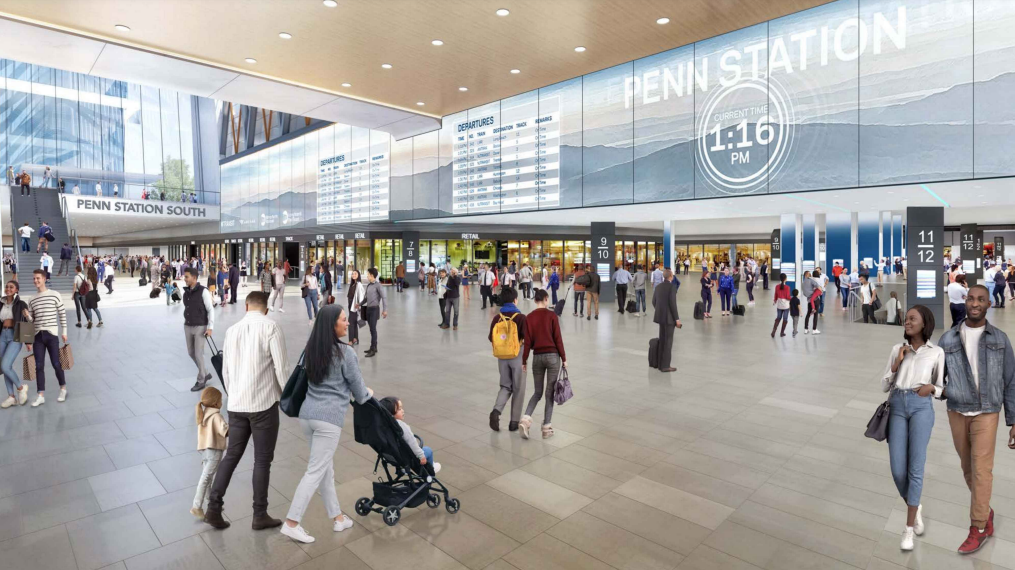Penn Station Plan Includes Bold, Risky Bet on New York City’s Future
A thrilling continuum begins to emerge as you descend from the High Line into Hudson Yards before reaching the Moynahan station between Eighth and Ninth avenues.

For now, no one is quite certain what will happen to the area around Penn Station in New York City, other than that something will happen. One might add that whatever that something is, it will surely be better than what we see there today.
The ambitious plan to revamp this dreary stretch of Manhattan was initiated by Governor Cuomo, and although his successor, Kathy Hochul, has made some show of changing this and that, in substance her plan appears to be largely in sympathy with his.
The plan itself has three main parts. The first, the Gateway Project, is the least controversial: Most everyone seems to agree that the century-old tunnel under the Hudson River, a crucial node for transportation up and down the entire eastern seaboard, is in need of urgent modernization.
The second part has to do with improving the functionality of Penn Station itself. That soul-crushing fiasco, functionally and aesthetically, opened 53 years ago and has only deteriorated since then.
With its low ceilings and murky lighting, its warren of uninviting spaces and its poorly conceived access to and from the trains, this space, the first thing many visitors ever see of New York City, almost seems designed to depress the spirits of all who enter and leave it.
It is far too early to comment in detail on the plans for the space, since so many plans for it have come and gone: still, it should be said that, as published, the preliminary architectural renderings from the governor’s office suggest a somewhat unimaginative and rigidly geometric modernism that is not so different, stylistically, from what we see today.
At least the architects, FXCollaborative, have learned something in the half century that has passed: and so the proposed space, with its concourse, is double the size of what it would replace, and its single level would be flooded with light from a skylit ceiling far loftier than the present one.
Also, the passages to and from the trains, we are promised, would be more congenial then they are today, with an additional 18 escalators and 11 elevators to the tracks. Perhaps the best thing would have been for the whole structure to be torn down and rebuilt from scratch, but for reasons of economy it was deemed wiser to revise the existing structure.
The third component of renovating the Penn Station area is more complicated than the first two. It consists of building 10 new skyscrapers that are to be “scaled back” relative to those that Mr. Cuomo proposed. Occupying spaces in the blocks between Seventh and Ninth avenues and between 30th and 34th streets, these buildings would be commercial and residential (with apartments that are either “affordable” or market rate) and expected to generate much of the money to cover the $6 billion to $7 billion that the state needs to raise for the rest of the project. The developer of this part of the plan, Vornado Realty Trust, already owns four of the 10 plots, and part of a fifth.
As regards both the commercial and the residential architecture, the proposed buildings represent a bold and perhaps risky bet on the future of New York City. It seems at this moment, at least, as though the residential part is a surer bet, since the appetite for housing, especially in Manhattan, appears to be nearly limitless. With the perhaps permanent decentralizing of work from offices to homes in the wake of the pandemic, though, it is not now clear if there will be enough tenants to fill the office buildings that are already in existence, let alone any new ones.
Nevertheless, the plan seems promising on the whole. Surely the piecemeal redevelopment of Midtown West, despite extensive coverage, has been one of the least hyped while most important modifications to Manhattan in the past half century. Although the locals, of course, appreciate that it is a big deal, perhaps they have not fully grasped how big.
Conceptually, we are apt to see it as three or even four unrelated or loosely related events: the completion of the High Line up to 34th Street; the development of Hudson Yards; the opening of the Daniel Patrick Moynahan Train Hall (formerly the Farley Post Office Building); and now these proposed renovations to Penn Station and its surroundings.
A thrilling continuum begins to emerge, though, as you descend from the High Line into Hudson Yards before reaching the Moynahan station between Eighth and Ninth avenues. What, for more than a century, had been one of the drabbest parts of the island has become one of the most inspiring, both in its modernity and in the sleekness of its designs.
Whether that progress can now continue all the way to Seventh Avenue remains to be seen. The future of Madison Square Garden is nebulous. It was ugly from the day it was planned and, more than 50 years on, it is only the worse for wear. As long as it stands in anything like its present form, the redevelopment of that portion of Midtown West can never be more than a qualified success.

